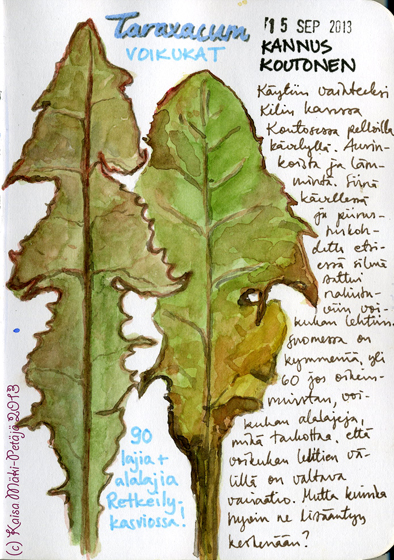Oh, dear. It has been quite a while since the last post. No excuses but procrastination.
It has been a really lousy winter up here: no snow but rain and utter darkness until last weekend practically. There was snow on Christmas Eve but by the evening of Christmas Day it was all gone again. So we managed to avoid black Christmas – that’s how we call one without snow here – even if just barely.
It get’s really dark here in Finland when there is no snow. There is only a little daylight: the sun rises and sets within hours. Wet ground and vegetation and the low-hanging clouds eat out all light but if there is even a tiny bit of snow on the ground, it reflects the light and brightens up the world. The wet and dark, melancholy conditions have also meant that I haven’t felt like drawing much at all so I don’t have any new drawings to share. Well, to be honest, I do have a few but I need find the energy to scan them first. In the mean time, here’s some less known knowledge about dandelions.
A dandelion is a dandelion, right? Nothing much to it. A common weed. A nuisance even.
Wrong.
The family Taraxacum contains innumerable species, subspecies and apomict microspecies. (Apomixis is a form of parthenogenesis in plants.) A Finnish field manual of plants lists 500 common forms of dandelions in Finland. The following are the most common ones of those 500:
crocodes, balticum, suecicum, fallicinum, fennobalticum, hjeltii, norvegicum, brachyceras, tornense, proxinum, falcatum, pseudofulvum, fulvum, isthimicola, rubicundum, marginatum, limbatum, scanium, croceum, praestans, sagittifolium, maculigerum, naevosum, kuusamoënse, cochleatum, chrysostylum, perattenuatum, galeatum, crassipes, triangulare, revalence, laceratum, pulcherrinum, biformatum, litorale, subhuelphersianum, obtusulum, pallidulum, remotijungum, ostenfeldii, canaliculatum, penicilliforme, speciosum, septentrinale, subpenicilliforme, cyanolepsis, tenebricans, sublaeticolor, porrigens, laciniosum, alatum, ingens, ancistrolobum, pallescens, croceiflorum, piceatum, sellandii, pallipedes, expallidiforme, xanthostigma, latissinum, fasciatum, longisquameum, patens, kjellmanii, obliquilobum, involuvratum, altissimum, subcanescens, hamatum, tumentilobum, reflexilobum, pectinatiforme, retroflexum, murconatum, adiantifrons, amplum, ekmanii, hamatum, cordatum, lucescens, glossocentrum, semiglobosum, angustisquameum, multilobum, imitans, lingulatum, dahlstedii, puolannei, aequilobum and polyodon.
So there you go. The easiest way to tell apart different kinds of dandelions is by the shape of their leaves. And, interestingly, I friend of mine told that the more serrated and rugged the edges of the leaves are, the stronger and more bitter the taste. A crucial piece of information if you are collecting leaves for a salad. And you can use the flowers for mead!
You – if you live in the Northern Hemisphere – have months before summer so there is plenty of time to learn to identify different varieties of dandelions. And they will be everywhere in your neighbourhood this summer too. And an endless subject for those of us who draw.
